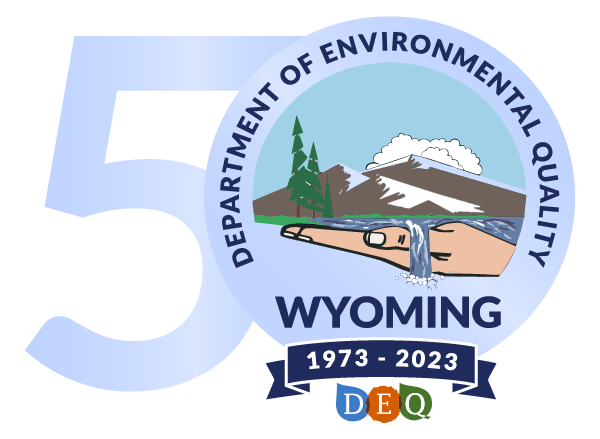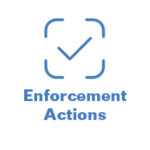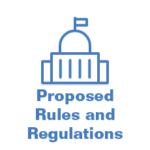- Home
- Public
- Resources
- Advanced Search
- Advisory Boards
- Careers
- District Offices
- e-Payment
- Enforcement Actions
- Meet the Director
- Mission Statement and Values
- Nondiscrimination Policy
- Outreach and Public Information
- Public Comments Online Portal
- Public Notices
- Records Requests
- Spill and Complaints
- State of the Environment
- Topics
- Divisions
- News
- Calendar
Large and Small Construction General Permit
- Home
- Water Quality
- WYPDES
- Discharge Permitting
- Storm Water Permitting
- Large and Small Construction General Permit

The DEQ undertakes enforcement actions to preserve safe environmental conditions throughout Wyoming.
This page contains information on the enforcement actions that the Water Quality Division may undertake, as well as a record of enforcement actions that have been undertaken by WQD.
If the download box is not working below, please click here.
Electronic document submittal is available for WQD permit applications, reports, and other communications.
Visit: WDEQ Water Quality Division Downloads
You do NOT need to follow up the electronic submission with a hard copy submission unless you are specifically contacted by a WQD staff person with a request to do so.
Need to report a spill or complaint? Please visit https://deqspills.wyo.gov/home
Submitting a public comment? WQD is unable to accept public notice comments through this system. Refer to the public notice document for instructions on how to submit comments or visit https://wq.wyomingdeq.commentinput.com/comment/search.
NOTICE: All applications for water distribution systems and/or sewage collection systems that are within the Cheyenne Board of Public Utilities (BOPU) district shall be submitted to the BOPU for approval. Contact Frank Strong or Bryce Dorr at (307) 637-6460, ENGreview@cheyennebopu.org, or http://cheyennebopu.org for additional information.
The DEQ Water Quality Division accepts comments on all permits authorized under a general permit for a period of 30 days, as provided for in W.S. 35-11-801(d).
Interested persons may mail or fax comments to the main Cheyenne office. The ‘Date’ column in the table below indicates the date the authorization was posted to the website. Comments must be received before 5:00 pm on the 30th day after the authorization was posted to the website. For example, comments for an authorization posted on 10/1/18 must be received by 5:00 p.m. on 10/31/18. DEQ does not accept emailed comments.
You may sort the table by posting date or search for the type of general permit, the county where the permit was issued, the permit number, or the name of the person or company to whom the permit was issued.
If you wish to review the general permit documents, please go to the web page for each permitting program:
- Storm Water Construction, Mineral Mining, and Industrial General Permits.
- Underground Injection Control (UIC) General Permits
- Water and Wastewater Construction General Permits.
- WYPDES General Permits
If the download box is not working below, please click here.
The Water Quality Division will present proposed revisions to Water Quality Rules Chapter 1, Wyoming Surface Water Quality Standards; and Chapter 2, Permit Regulations for Discharges to Wyoming Surface Waters to the Water and Waste Advisory Board at their June 13, 2024 meeting, starting at 9:00 a.m. The proposed revisions to Chapter 1 (1) fulfill the federal requirements at 40 CFR § 131.20, (2) restructure and align requirements with state law and federal law, regulations, and guidance; (3) revise designated uses and remove the designated use classification system; and (4) provide minor updates to specific water quality criteria. The proposed revisions to Chapter 2 (1) update references to the designated use classification system to reflect proposed revisions to Chapter 1; and (2) incorporate provisions related to fish toxicants, aquatic pesticides, and short-term sediment disturbance that Water Quality Division proposes to move from Chapter 1 to Chapter 2. More information is available at: http://deq.wyoming.gov/shwd/wwab/ under the “Upcoming Meeting” tab
All official Wyoming State Rules and Regulations are kept at the Wyoming Secretary of State’s Office. Click here to view all current Rules and Regulations.
Large and Small Construction General Permit
This resource contain documents related to Large Construction General Permitting. Please note that documents relevant to the construction general permits (NOIs, templates, guidance, etc.) are in a separate list at the bottom of this webpage.
There are two Construction General Permits (CGPs).
The Large Construction General Permit (LCGP) covers storm water discharges from construction activities that disturb 5 or more acres. Large construction activities also include disturbances of less than 5 acres when that disturbance is part of a larger Common Plan of Development or Sale that will ultimately disturb five or more acres (See the LCGP Part 2.4 for additional information). To apply for coverage under the LCGP you will need to provide a complete Notice of Intent (NOI), a complete Storm Water Pollution Prevention Plan (SWPPP), the appropriate permit fee, and a map showing access to the facility from a public road. See the NOI for more detailed information regarding securing and documenting facility access. Visit the Fee Calculator webpage to calculate your fee.
The Small Construction General Permit (SCGP) covers storm water discharges from construction activities that disturb at least one acre, but less than five acres. Small construction activities also include disturbances of less than 1 acre when that disturbance is part of a larger Common Plan of Development or Sale that will ultimately disturb between one and five acres (See the SCGP Part 2.4 for additional information).
Rainfall erosivity is a term used to describe the potential for soil to wash off disturbed areas and into surface waters of the state during storms. Operators of small construction activities may qualify for a waiver from the requirements of the SCGP provided the calculated rainfall erosivity “R factor” for the entire period of the construction project, from initial land disturbance to “final stabilization” is less than 5. See the instructions on the Erosivity Waiver Form (Updated 2/2022) for several R calculation methods, as well as information in SCGP Part 4 (updated 11/2021). There is no fee to apply for this waiver but applications must be received at least 30 days prior to construction start date. If the project qualifies, you will receive a formal Erosivity Waiver.
Important note about the SCGP: Unlike obtaining coverage under the LCGP, the SCGP is a “no-application” permit. Obtaining coverage is similar to a permit-by-rule in that by following all provisions of the permit your project will be covered by the permit.
Beginning July 1, 2013 payment of permit fees for individual permits and general permit authorizations are required to be submitted with the permit application or NOI form. All storm water authorizations have variable fees that must be calculated depending upon the NOI date. The “Fee Calculator” should be used to determine the proper amount to be submitted with each NOI. Checks should be made out to the “Dept. of Environmental Quality, Water Quality Division.
The linked list represents consultants who have indicated that they are are available for hire by the public to provide services relating to compliance with the Wyoming Large and Small Construction General Permits and who have requested to be on this list. The Wyoming Department of Environmental Quality does not certify or recommend any consultants.
Pursuant to the requirements of the Governor’s Executive Order 2019-3 (EO 2019-3), Greater Sage-Grouse Core Area Protection, the Wyoming Department of Environmental Quality (WDEQ) is working with the Wyoming Game and Fish Department (WGFD) to minimize the impact of development on the Greater Sage-Grouse population in Wyoming. To that end, operators of large or small construction projects must determine if any part of their project is subject to EO 2019-3 before applying for coverage under the Large Construction General Permit (LCGP) or operating under the (no application required) Small Construction General Permit (SCGP). If any part of your project falls within a Sage-Grouse Core Area (SGCA), Connectivity Area, Winter Concentration Area, or within two miles of a Non-core Area sage-grouse lek as determined under EO 2019-3, then the project sponsor must first contact the WGFD Habitat Protection Program to determine their proposal’s consistency with the EO.
For new projects subject to EO 2019-3 that need LCGP coverage, the Storm Water Program will require a letter from the WGFD noting that the project is either consistent with the EO or that the project is considered de minimis before we can process a Notice of Intent. For coverage under the SCGP, the project operator is responsible for completing the required consultation and obtaining a letter of consistency or de minimis.
Projects that are not consistent with EO 2019-3 are not eligible for coverage under either CGP. See the LCGP or SCGP for further information. Please also visit the WGFD’s Sage-grouse Management Page for more information: https://wgfd.wyo.gov/Habitat/Sage-Grouse-Management.
Pursuant to the Governor’s Executive Order 2020-1 (EO 2020-1) the Wyoming Department of Environmental Quality is working with the Wyoming Game and Fish Department (WGFD) to minimize the impact of development in designated Migration Corridors. EO 2020-1 requires development activities within designated migration corridors be conducted in accordance with certain practices and stipulations specified in the EO and in any additional correspondence from the Wyoming Game and Fish Department (WGFD). Applicants for state permitted projects that are partially or wholly within a designated migration corridor are required to consult with the Wyoming Game and Fish Department to determine if their proposed project will have adverse effects on migration corridors.
For new projects subject to EO 2020-1 that need LCGP coverage, the Storm Water Program will require a letter from the WGFD noting that the project is either consistent with the EO or that the project is considered de minimis before we can process a Notice of Intent. For coverage under the SCGP, the project operator is responsible for completing the required consultation and obtaining a letter of consistency or de minimis.
Projects that are not consistent with EO 2020-1 are not eligible for new coverage under either CGP. See the LCGP or SCGP for further information. Please also visit the WGFD’s Management Page for more information and a map of the currently designated Migration Corridors:
https://sites.google.com/view/wywildlifemigrationadvisorygrp/home?fbclid=IwAR3y_HEQxOo4HckAVKzRzT5kdLaOsyiV0vt9NJOtzNu45b_WK0vESwTWVzY#h.bc90kvcpohnu.
This section was updated December 16, 2020
Please note that both the WYPDES large and small construction storm water permits now cover discharges from construction dewatering if those discharges are accumulated storm water with only minor amounts of groundwater (see Part 7.11 of the large construction permit or the small construction permit for more details). Discharges that have a significant groundwater component and that are pumped or siphoned to a storm drain or may reach a surface water of the state, directly or by overland flow, are considered a process wastewater and must be covered under a separate WYPDES permit for wastewater discharges.
Most short-term construction dewatering discharges to storm drains or surface waters may be covered under a general permit specifically written for short-term, temporary discharges. Contact Kathy Shreve, 307-777-7093, for more information on permitting temporary discharges.
If you will be “land applying” construction site water to the land surface so that it will not run off to surface waters, contact your local District Engineer with the Water and Wastewater group to determine if a “Land Application” permit is required.
Both a WYPDES Temporary Discharge permit and a Land Application permit will take some time to obtain. If you think you may need to dewater your site consider getting one of these permits early to avoid delays in your project. (8/05) (revised 12/06)
May be required for certain construction activities conducted in live waters
The Administrator of the Water Quality Division may authorize temporary increases in turbidity above the numeric criteria (described in Section 23, Chapter 1 of the Wyoming Water Quality Rules and Regulations) for certain short-term, construction-related activities.
If a project requires working in live waters and activities may cause an excursion above allowable turbidity levels, your project may qualify for a turbidity waiver. This waiver is time-limited and project-specific. To apply for a waiver use the application linked below. Contact Eric Hargett, 307-777-6701, for more information.
Projects that cause excursions above the numeric criteria and that have not been authorized by a waiver are subject to a possible enforcement action.
In Wyoming, where the Department of Environmental Quality is the permitting authority, Chapter 2, Section 6 of the Wyoming Water Quality Rules and Regulations requires permit coverage for storm water discharges from all construction activities disturbing one or more acres. The type of facility being constructed does not change the requirement to obtain permit coverage. As such, construction of oil and gas facilities still requires storm water permit coverage in the state of Wyoming.
However, passage of the Energy Bill does affect storm water permitting for the oil and gas industry in areas of the Wind River Indian Reservation where the state does not have jurisdiction and EPA is the permitting authority. For more information contact Amy Clark at EPA Region 8 (303-312-7014).
| NAME/EMAIL ADDRESS | PROGRAM | PHONE |
| Jason Thomas | WYPDES Program Manager | 307-777-5504 |
| Discharge Permitting | ||
| Kathy Shreve - Supervisor | Discharge Permits | 307-777-7093 |
| Mike Locatelli | Discharge Permits | 307-777-7081 |
| Eric Pribil | Discharge Permits | 307-777-8991 |
| Anita Rehner | Storm Water Permits | 307-777-5622 |
| Katy Sprouse | Storm Water Permits | 307-777-7570 |
| Inspection, Compliance & Enforcement | ||
| Kevin Wells - Supervisor | Inspection, Compliance & Enforcement | 307-777-8669 |
| Kevin Campbell | NetDMRs, Transfers & Terminations, Compliance & DMRs | 307-777-2431 |
| Katherine McCrea | NetDMRs, Compliance & DMRs | 307-777-5990 |
| Jim Eisenhauer - Coordinator (Sheridan) | Inspections | 307-675-5636 |
| Jessica Barnes (Sheridan) | Inspections | 307-675-5631 |
| Jon Deutscher (Sheridan) | Inspections | 307-675-5635 |
| Brad Kniss (Cheyenne) | Inspections | 307-777-2457 |
| Eric Moore | Inspections | 307-335-6956 |
| Christy Hutchinson (Casper) | Inspections | 307-473-3468 |
| Ann Heuerman (Casper) | Inspections | 307-473-3474 |
| Tori Nye (Pinedale) | Inspections | 307-349-7474 |
- WYPDES permit fees were raised on July 1, 2020. Fees for storm water permits changed from $100 per each 12-months to $200 per each 12-months. The maximum fee will be $1000 for a five year term. All WYPDES permits are affected whether storm water or discharge permits. Permit fees cannot be pro-rated for partial years. Visit our fee calculator. (December 28, 2020)
- The Water Quality Division is requesting that the public submit documents (applications and other forms) via an upload link whenever possible. Please see more information about what can be uploaded here: https://deq.wyoming.gov/water-quality/ (April 2, 2020)
Beginning July 1, 2013 payment of permit fees for individual permits and general permit authorizations are required to be submitted with the permit application or NOI form. Some types of permits have flat fees and others have variable fees that must be calculated.
This "Fee Calculator" should be used to determine the proper amount to be submitted with each application or NOI. Checks should be made out to the "Dept. of Environmental Quality, Water Quality Division.
This resource page contains guidance documents related to WYPDES Storm Water Permitting.
Best Management Practices
- City of Casper Storm Water Web Page. The City of Casper has put together a web page with many resources for homeowners to contractors. (12/07)
- A Guide to Temporary Erosion-Control Measures for Contractors, Designers and Inspectors (Available Below): The state of North Dakota has produced this excellent and straightforward guidebook for temporary erosion controls on construction sites. (6/05)
Erosion and Sediment Control Best Management Practices for the City of Casper Wyoming. Casper has published this manual for contractors working in Casper. In addition to recommended BMPs the manual has information City ordinances addressing erosion control. (9/05)
- Cover Page for Manual (Available Below for Download)
- BMP Manual (Available Below for Download)
- Manual Appendices (Available Below for Download)
This EPA site has published a number of webcasts addressing many aspects of storm water. They may be appropriate for construction, industrial, or municipal applications. Other EPA storm water related resources including a National Menu of BMPs and various fact sheets can be found on this page.
National Stormwater Best Management Practices (BMP) Database - This database provides monitoring results measuring the effectiveness of structural and non-structural BMPs used around the country. http://www.bmpdatabase.org/
Protecting Water Quality in Urban Areas - This document from the Minnesota Pollution Control Agency has a wealth of information on protecting surface waters in urban areas.









